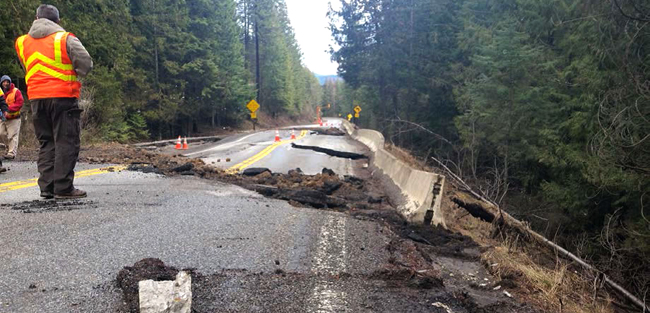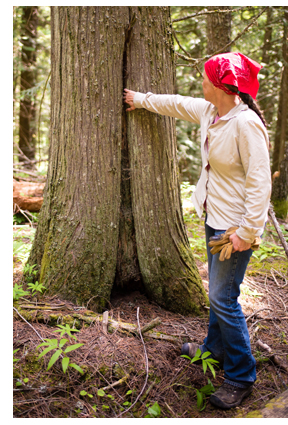

Landslide leads to teamwork and cultural revival
![]()
In the shadows of the Pedee Creek Cedar Grove in north Idaho, collaborative efforts to repair Idaho Highway 5 after a landslide last March have renewed a cultural tradition.
The landslide occurred outside of Plummer on ID-5 near Heyburn State Park and the Coeur d’Alene Reservation. The highway closed due to the damage, adding several hours to the commute between Plummer and St. Maries. In the weeks after the slide, the Idaho Transportation Department cleared the road and began planning a long-term solution.
“It was a joint effort between ITD, the tribe and the state park,” said Marvin Fenn (pictured below, left), the ITD District 1 engineering manager for the north Idaho region. “Within weeks, we developed a plan to repair the road, identified the impacts to the environment nearby and worked together to mitigate these impacts. It didn’t become bureaucratic.”
To prevent future landslides, Fenn said ITD developed a project to install a deep keyway, but installing the keyway would require the removal of a grove of cedar trees next to the highway, including some trees that were growing on the Coeur d’Alene Reservation.
Installing a keyway would include replacing unstable material with a sturdy rock mixture to prevent future landslides, but at a cost to a cultural resource. ITD was obligated to not only repair the road but to also minimize any environmental effects.
These obligations created a dialogue between the Coeur d’Alene Tribe and ITD and ultimately allowed them to work together toward a solution, said Mike Hartz, the ITD environmental planner at District 1 responsible for coordinating environmental documentation.
“We took the time to understand what the resource was and their concerns, and we embraced their perspective to offset our effect to this resource,” Hartz said.
As part of the resulting discussions, ITD coordinated with the tribe to allow members to harvest bark in early November prior to the removal of the grove and before the finalization of the mitigation agreement, which was just signed in early January.
Jill Wagner (pictured below), a tribal historic preservation officer who attended the harvest  and helped identify ways to mitigate impacts from the repairs, said cedar played a significant role in the tribe’s culture.
and helped identify ways to mitigate impacts from the repairs, said cedar played a significant role in the tribe’s culture.
Wagner said the tribe has historically used cedar bark and trees to fashion canoes, create structures and fuel fires, as well as make baskets to carry food and to store water.
“Part of what I realized as an anthropologist is that there is no tradition of pottery in this area,” Wagner said. “I realized the tribe didn’t need pottery because we had cedar baskets.”
However, as the region developed, cedar groves became less common, and the tribe could no longer make baskets.
Although the tribe’s culture department does not know the last time cedar was harvested in the Pedee Creek area, the answer might be found soon, in part due to the landslide mitigation agreement and the removal of the grove.
As part of the agreement, ITD will remove the grove to install a keyway to stabilize the slope below the highway. The cedar logs will be transferred to the tribe to give members the opportunity to restore its many traditional uses. With additional support from ITD, the tribe will research the entire history of the area and will be shared through the creation and distribution of an educational booklet, Wagner said.
“You know it is not a good experience to have a highway fall down and have to cut down trees,” Wagner said. “But it is working as well as it can. It is a positive experience, and I’m excited to further local understanding of the area’s history and culture.”
Published 02-02-18